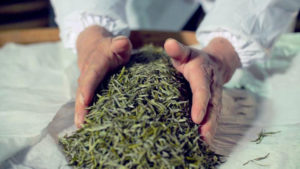Authentic Junshan Yinzhen is amongst the rarest of China’s famous teas. As the only example of yellow tea on China’s list of most famous tea, it is the foremost representative of this endangered art form. Its restricted growing region and painstakingly complex labor required by its production restrains the output of genuine Junshan Yinzhen to a total of only five hundred kilograms each year.
Cultivation Conditions

Jun Shan or Jun Mountain is in fact an island on Dong Ting Lake in Hunan province. Stretching only one kilometer wide, this small area is the exclusive growing region for Jun Shan Yin Zhen. On the island, fertile soil takes on the summer floodwaters of the Yangzi river in leaving it rich with silt. The island’s landscape is enrobed in fog and mist throughout the year. These conditions are considered especially good tea cultivation and are unique to Jun Shan island. Both the island and the shores of the lake surrounding it produce tea. Tea grown on the shore of Dong Ting lake is not considered true Junshan Yinzhen. True Jun Shan Yin Zhen can only be grown in the special climate of Jun Shan island.
Confusion Around Junshan Yinzhen
In addition to its specific environ, equally important to the cultivation of authentic Junshan Yinzhen is the use of the local tea bush cultivar, characterized by its tight and slender buds. Local bushes have an unmatchable richness in their flavor and retain all the original nuances of this famous tea. In recent time the regional government has experimented with growing different styles of tea bushes on Jun Shan Island and around Dong Ting Lake, even promoting planting the popular Da Bai Hao white tea bush from Fujian and the high out put Long Jing No. 47 tea bush from Zhejiang. Unfortunately, “Jun Shan Yin Zhen” from these tea bush cultivars is not openly noted as such on the consumer market, leading to much confusion and difficultly to obtain an authentic product. The scarce examples of Junshan Yinzhen we’ve seen available in the west are dominantly made from the Da Bai Hao cultivar.
He Shou Wu, an Herb, Believed to Add to Flavor of Local Bush
Finally, a small but noteworthy influence on the agriculture of Junshan Yinzhen is a medicinal herb, He Shou Wu (Polygonum multiflorum), which grows clinging to the trunks of the tea bushes thoughout the island. In the old government plantation days it was custom to harvest the He Shou Wu and sell it in the off season. Some suggest the intermingling of this herb is responsible for the distinctive flavor of the local tea bushes grown on the island.

Production
Junshan Yinzhen’s entire production, from its stringent picking to its unusual seventy-two hour oxidation is done only with the aid of simple tools and requires constant attention to detail.
The Plucking
Even its picking is markedly detail oriented when compared to other bud tea. Most bud teas are picked as one bud and one leaf which are later separated from each other. The production of Junshan Yinzhen demands that tea pickers pluck only buds, the hardest picking standard. Tea pickers are required to pluck the buds without the use of their fingernails; rather pickers must gather the bud by breaking it from its stem with a twist. It takes 60,000 of these carefully harvested buds to yield just one kilogram of Junshan Yinzhen. The reason for their special picking is to minimize direct handling of the raw buds and protect the quality of their oxidation in the next stages of production. The oxidation of yellow tea is so precisely controlled that the oils and moisture from a worker’s hand can have a noticeable influence in the final product.

The Oxidation Process
After plucking, the production of Jun Shan Yin Zhen begins in a way similar to some green teas, with a pan firing that lasts for a few minutes. The tea is still wet and hot after firing. Rather than dry it further, it is wrapped a special type of thick paper and then put in wood cabinet and left to undergo very slow oxidation. During the oxidation period, the tea is stirred. This step disperses the heat created by oxidation. How often the tea is stirred depends on ambient temperatures. Heat, like moisture, is a variable that speeds oxidation in tea.

After roughly two days in the cabinets, the tea is refried again to further remove moisture from it. After which it is rewrapped and stored for one more day in the cabinets. Once the final round of oxidation is complete the tea is removed from cabinets and then dried at low temperature in bamboo basket over charcoal. The basket has a unique size and shape, similar to a Djembe drum with distorted hour glass-like dimensions, narrowing at its center with a wide top and bottom. Tea is shaken in the basket to dry it evenly. This final drying is the most skill intensive step in production because the slow charcoal drying brings out complexities of teas flavor precursors and perfects the fragrance of the dry leaves.
Throughout this entire three day process there is no direct hand tea contact with the exception of the pan firing after picking. By the final stages of production the tea has become an even light yellow color. To achieve this consistency, the tea master carefully controls the temperature of frying and during oxidation, knowing when to stir the tea and knowing at just what temperature to keep the coals in the final drying process.

The result of this three day struggle with minute chemical processes yields a result that is nothing short of exquisite. Jun Shan Yin Zhen, masterfully produced, brews liquor with a very floral nose developing as the tea cools. Body starts in front pallet, lingers and migrates to mid pallet where it sustains its rich complexity. Although strong in flavor, it doesn’t shock the rear palate with a sour tang like many green teas or light wulong.
